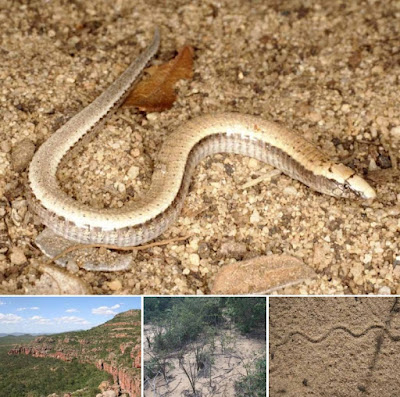 |
| Scriptosaura catimbau
Rodrigues & Maranhão dos Santos, 2008
|
Abstract
Scriptosaura catimbau, a new genus and species of elongate, fossorial, sand swimming eyelid-less gymnophthalmid lizard is described on the basis of specimens obtained at Fazenda Porto Seguro, municipality of Buíque, State of Pernambuco, in the Caatingas of northeastern Brazil. The type locality is entirely included within the area of the recently created Parque Nacional do Catimbau. The new lizard lacks external forelimbs, has rudimentary styliform hindlimbs and is further characterized by the absence of prefrontal, frontal, frontoparietal and supraocular scales, and by having one pair of chin shields. A member of the Gymnophthalmini radiation, the new genus is considered to be sister to Calyptommatus from which it differs externally by the absence of an ocular scale and absence of an enlarged temporal scale.
Key words: Scriptosaura catimbau, new genus, Gymnophthalmidae, taxonomy, Catimbau Nacional Park, Pernambuco State, Brazil, Caatingas
 |
| FIGURE 3. Living specimen of Scriptosaura catimbau from Parque Nacional do Catimbau. |
Scriptosaura, gen. nov.
Definition: An elongate and short tailed gymnophthalmid lacking an ear opening and eyelid. Forelimbs absent, hindlimbs rudimentary, styliform, ending in a short apical scale; nail absent. Frontonasal single; prefrontals, frontal, frontoparietals, supraoculars, and loreal absent. Parietals longer than wide, contacting frontal. Nostril in the center of nasal. Collar fold absent. One pair of chin shields. Dorsal scales cycloid anteriorly, posteriorly smooth, hexagonal, keeled and slightly mucronate, in regular transverse series; lateral scales enlarged, smooth. Ventral scales smooth, in four regular transverse series, the external ones wider. Males with four preanal pores, absent in females.
Etymology: From the Latin “scriptor” = writer, and “saura” = lizard in reference to the sand tracks left by this sand swimming species. The tracks are in the origin of its popular name (escrivão = public writer) which is also attributed to other similar sand swimming lizards like those of the related genera Calyptommatus and Nothobachia.
Scriptosaura catimbau, sp. nov.
Etymology: A noun in apposition, in reference to the type locality, Parque Nacional do Catimbau.
 |
| Scriptosaura catimbau Rodrigues & Maranhão dos Santos, 2008 |
Resumo: Scriptosaura catimbau, um novo gênero e espécie arenícola de lagarto gimnoftalmídeo fossorial com corpo alongado e sem pálpebra é descrito com base em espécimes obtidos na Fazenda Porto Seguro, município de Buíque, estado de Pernambuco, nas Caatingas do nordeste brasileiro. A localidade tipo está inteiramente incluída no recentemente criado Parque Nacional do Catimbau. O novo lagarto, sem membros anteriores e com membros posteriores reduzidos a apêndices estiliformes caracteriza-se pela ausência de prefrontal, frontal, frontoparietal e supraocular e por apresentar um único par de escudos pós-mentais. O novo gênero pertence à tribo Gymnophthalmini e é considerado irmão de Calyptommatus do qual difere externamente pela ausência de escama ocular e de uma escama temporal muito aumentada, características do último gênero.
Palavras chave: Scriptosaura catimbau, gênero novo, Gymnophthalmidae, taxonomia, Parque Nacional do Catimbau, Estado de Pernambuco, Brasil, Caatingas
Miguel Trefaut Rodrigues and Ednilza Maranhão Dos Santos. 2008. A New Genus and Species of Eyelid-less and Limb Reduced Gymnophthalmid Lizard from northeastern Brazil (Squamata, Gymnophthalmidae). Zootaxa. 1873; 50–60.
